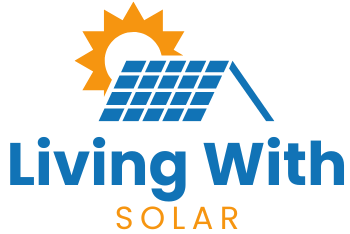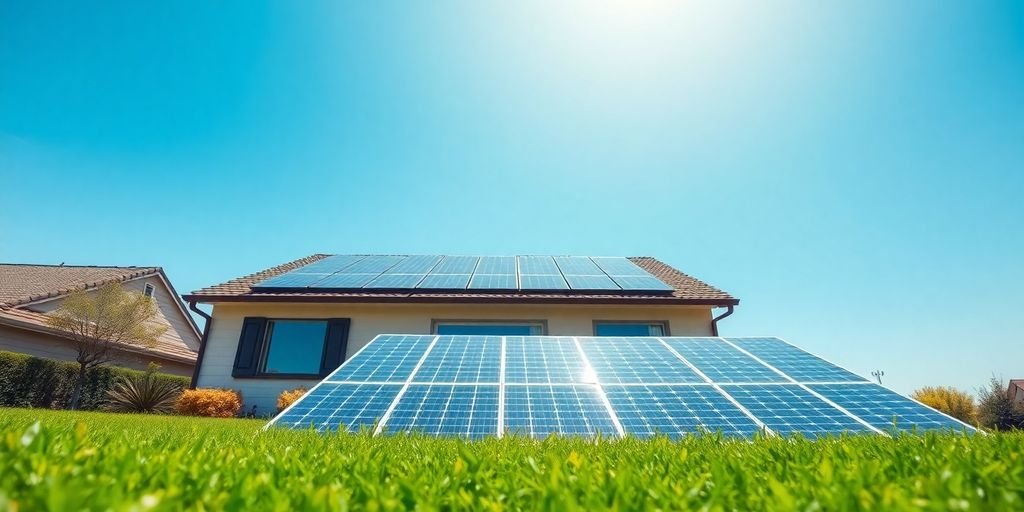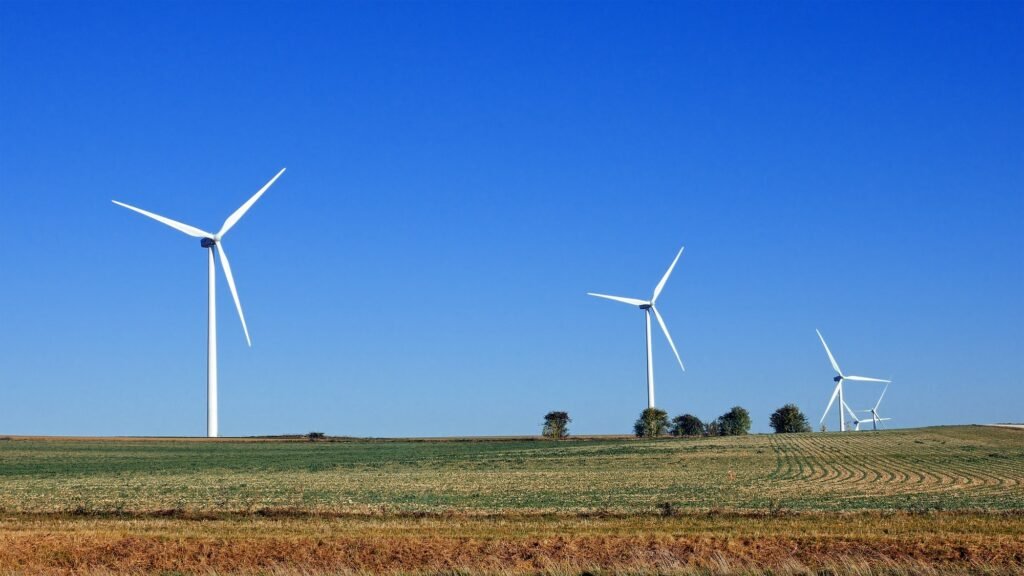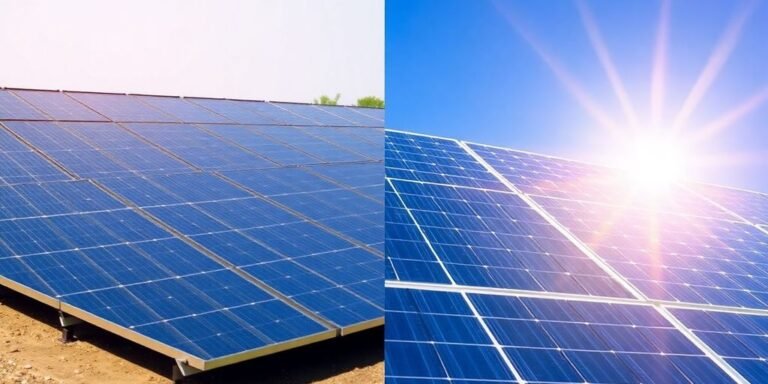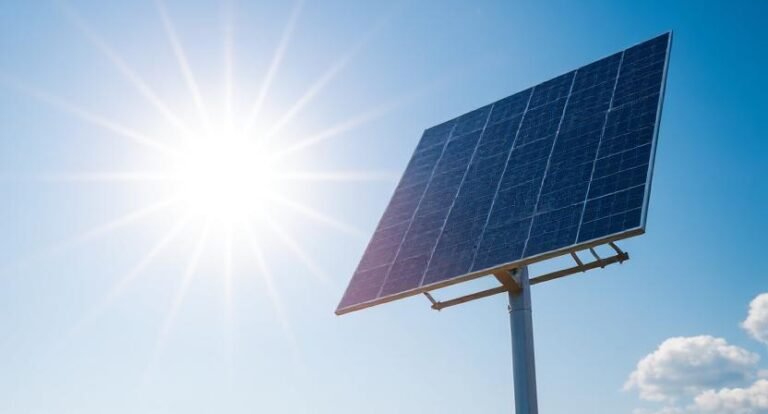Considering solar panels? It’s a huge decision, and one of the first questions people have is how much it will affect their monthly solar panel bill. It’s not always so straightforward as slashing your electric bill to zero. A bunch of factors play into it, from how much sun your house gets to the agreement you cut with your utility company. Let’s dissect what you can expect after you go solar.
Understanding Your Present Electricity Bill
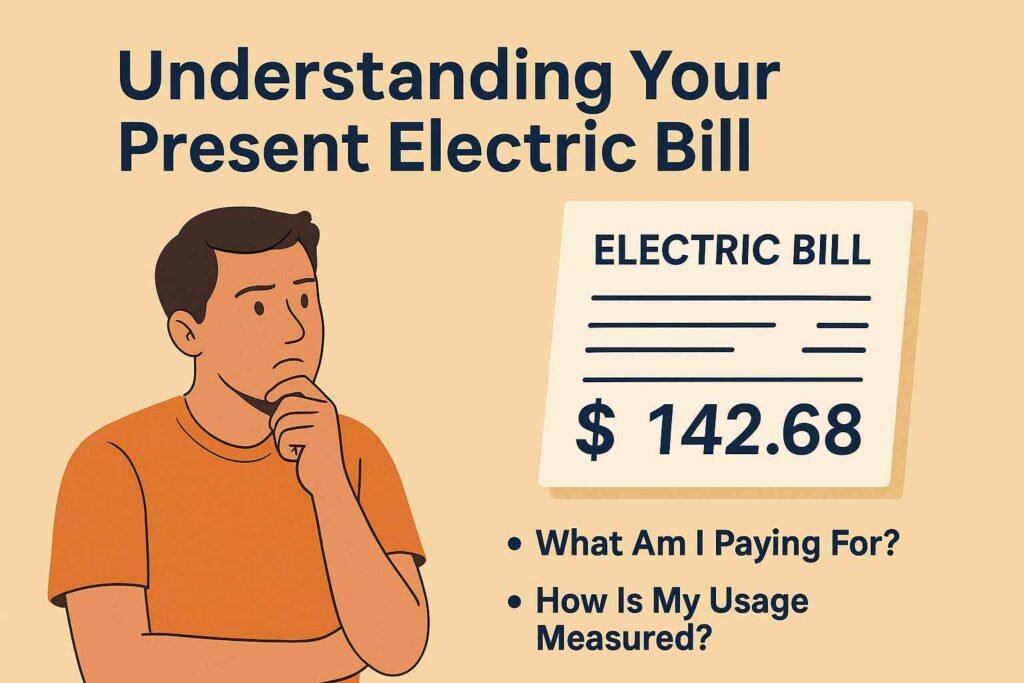
The truth is, before I so much as give thought to how solar panels might affect that, I need to first and foremost straighten out my electricity bill situation.
There’s more to it than just a number at the bottom; there’s some stuff bubbling around in there, and understanding at least some of that is crucial to being able to see where the savings are going to end up coming from. You know, I used to just look at the total and groan, but now I’m trying to get to the bottom of each line item. Sometimes it’s a little bit like decoding a secret code, but that’s part of the fun.
What Am I Paying For?
When I look at my bill, I can identify some main categories. For one, there’s the electricity I consume, measured in kilowatt-hours (kWh). Here is the variable bit I get the more I play. There are also set charges I pay no matter how much electricity I use.
These can include things like keeping up the grid, as well as customer service. It’s a little frustrating to have to cough that up even when I’m trying to be super energy-efficient, but I guess someone needs to keep the lights on in the literal sense.
There are taxes and other fees, which are often a percentage of the total or a flat amount. It’s a fairly standard breakdown, but the individual prices and amounts can differ significantly based on my location and electric provider.
How Is My Usage Measured?
I have one or more metered devices that measure my electricity consumption somewhere on my property. This meter monitors every kilowatt-hour (kWh) of electricity that is drawn into my home. One kilowatt-hour is what it takes to operate a 1,000-watt appliance for an hour. So if I turn on a 100-watt light bulb for 10 hours, that’s 1 kWh.
This meter is read by my utility provider, and a reading is either taken remotely, or a worker would visit the premises to take a reading and then use that reading to calculate how much I owe for my bill, based on the total kw/h consumed during the billing period. It’s pretty simple, but now and then I find myself wondering if I’m getting an accurate read, particularly when my bill is especially high.
I’ve found that there’s more to decipher about my electricity bill than just the total due at the bottom. It is the act of dissecting the charges, seeing how my usage affects the cost, and finding ways to scale back. It is that fundamental understanding which will allow me to better enjoy the financial opportunities of the basics of the financial windfall, with which I can capitalize on my monthly expenses.
Peak and Non-Peak Rates Explained
This is where the matter gets a bit trickier. Some utility companies, mine included, have so-called time-of-use (TOU) rates. This is to say that the price I pay for electricity can change based on the time of day. Generally, there are:
- Peak hours: These typically are late afternoon and early evening, when electricity demand is greatest. This is at the most expensive time of day for electricity.
- Off-peak hours: Generally overnight and during the day, when demand is less. Those are situations when electricity is relatively cheaper.
- Shoulder hours: Some utilities have “shoulder hours” as well, which are in between peak and off-peak, with a midrange price.
I have attempted to modify my behavior to shift demand for more electricity during off-peak times by, for example, running the dishwasher late at night, doing laundry on weekends. It’s a little thing, but it could add up to something big in my overall bill. If I knew the solar needs of my home, I could get a sense (with the help of some data analysis) of how much I could shift consumption to have the greatest impact on savings with a solar system.
Components of a Typical Utility Bill
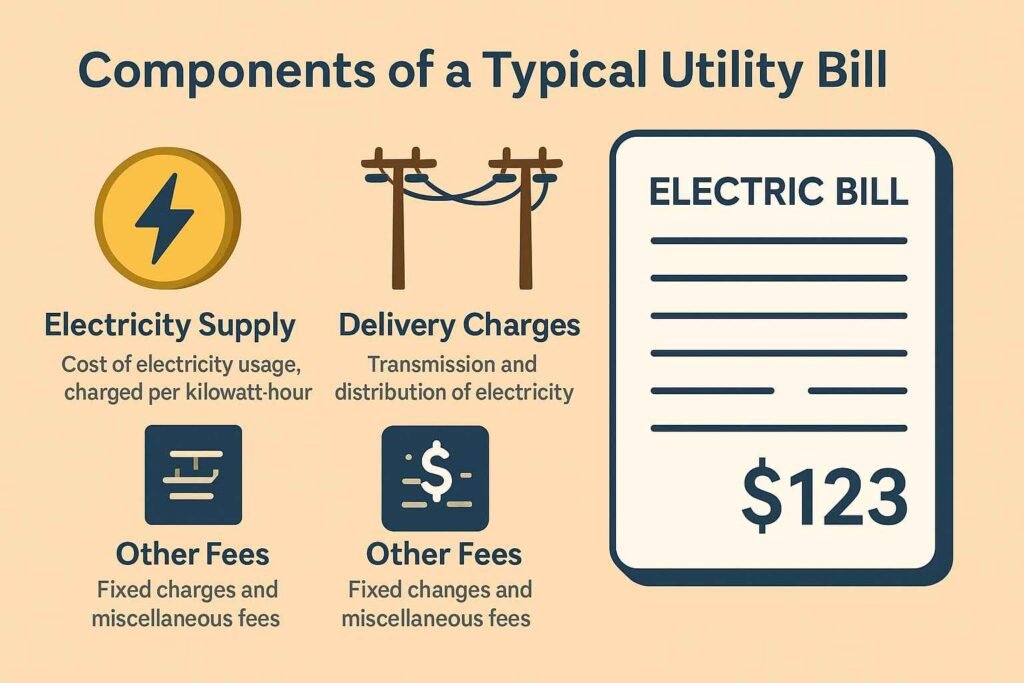
I see my electricity bill, and it is not just one huge chunk of money. It’s a breakdown of multiple separate fees that contribute to the total amount. Knowing these parts enables me to see where my money is going and how solar panels might make a difference. The key ingredients generally are charges for the electricity I consume, delivery fees , and often other fixed fees.
First, there is the psychiatric power surge. That’s the price I pay for electricity based on how much I use per kilowatt-hour (kWh). That’s the easy part, because it simply equates to how much power my home consumes. For some utilities, it’s a flat rate, so I pay the same rate per kWh no matter when I use it.
Others have what’s known as a “time-of-use” rate, so that the cost per kWh varies by the time of day. For instance, electricity might be more expensive in the middle of the afternoon and cheaper later at night. This can have a big impact on my habits, like not running the dishwasher during dinner prep.
Then there are the delivery charges, transmission, and distribution fees. These aren’t for the electricity itself, but rather for the service of transporting that electricity from the power plant to my home. It includes the upkeep of power lines, substations, and all the infrastructure that ensures the lights stay on.
Even if I produce some of my own power with solar panels, I’ll still be connected to the grid and rely on its lines anyway, so these fees tend to stick around. If I never leave my house, I’m still paying for the road.
“I’ve come to understand that my utility bill is an awful lot more than a fee for power. It’s a combination of how much electricity I consume, the cost of getting the electricity to my house, and some basic charges for being connected to the grid. Knowing the parts of that system explains to me how my use of energy affects my wallet and how solar energy can help me save when those monthly energy bills arrive.”
– Maria Sew
Here is a breakdown of these charges in simple terms:
- Energy Charge: The rate you pay for each kWh used.
- Delivery Charge: Costs to deliver and distribute electricity.
- Customer Charge: A uniform monthly charge for utility services.
- Taxes and Surcharges: Extra charges levied by local or state governments.
Knowing these factors is the first step to determining the potential effect of solar panels on my total electricity costs. It’s not just about cutting the energy charge, it’s about getting a broader state of affairs on my relationship with my utility.
How much is a monthly solar energy bill
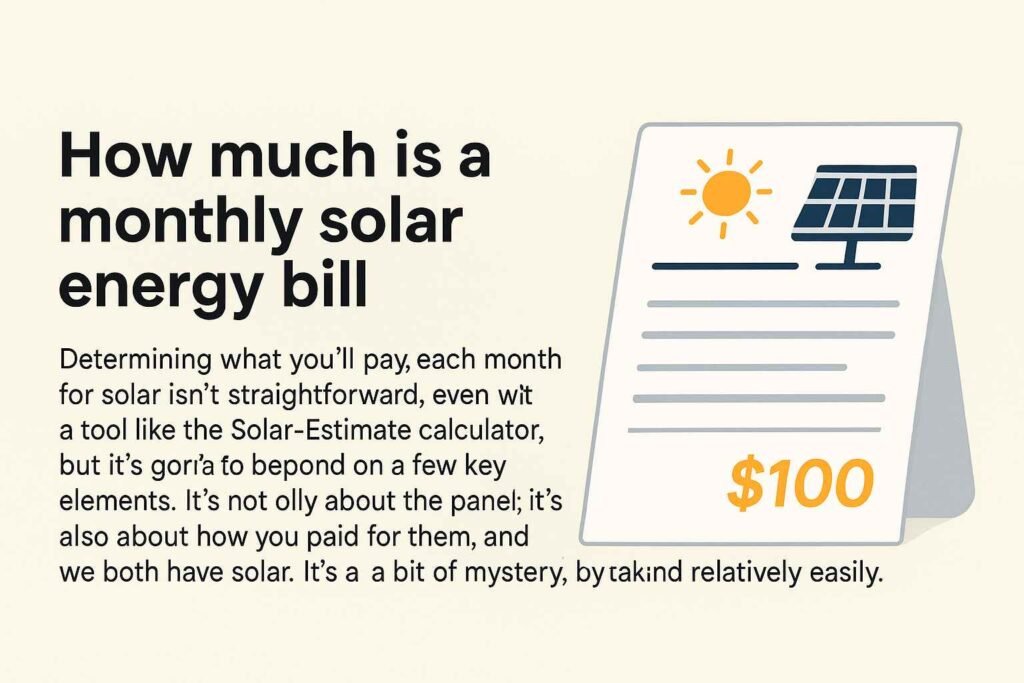
Determining what you’ll pay each month for solar isn’t straightforward, even with a tool like the Solar-Estimate calculator, but it’s going to depend on a few key elements.
It’s not only about the panels; it’s also about how you paid for them and how much power you’re actually consuming. I mean, you know, my neighbor, his bill is a thousand different than mine, and we both have solar. It’s a bit of a mystery, but it is solved relatively easily by taking it apart.
Solar Bill Breakdown
It’s not one number when I look at my solar bill breakdown. Here are some of the pieces that form what I pay each month. For one, there’s still a utility bill, even with solar. T
his includes things such as connection fees and any electricity I take from the grid when my solar panels aren’t generating enough, such as at night or when it’s cloudy. And then, if I financed my system, there’s that monthly payment. It’s not what the traditional sense of a “solar bill” but it’s a monthly expenditure linked with having solar. And if I’m renting, well, that’s yet another monthly fixed payment. It’s a lot to manage, but it’s worth breaking it all down.
- Fixed charges for the use of utilities (non-negotiable, even if you generate all your power)
- Solar loan installment (if you bought your system with a loan)
- Solar lease payment (if you had a solar lease agreement)
- Any annual maintenance or monitoring fees (though these are typically very small, or they’re included).
I’ve discovered that despite solar, I’m still left with a tiny utility bill. It is generally only for the low base service charge and any small amount of power I buy from the grid. It’s nowhere near what I used to pay, but it’s not zero. It’s worth keeping in mind that the addition of solar to the top of a roof doesn’t always translate into saying goodbye forever to your utility company.
Average Monthly Savings Solar
So, what is the average monthly savings that solar provides? Here is where it gets interesting. My electricity bill is way down, for instance. “I was paying hundreds of dollars a month before solar, especially in the summer with the AC blasting.”
Now, my utility bill will be nothing but the basic service charge, maybe $10-$20. The actual savings all stem from needing to buy less electricity from the grid. I feel like I’m making my power, and it’s a huge burden off my wallet.” The savings you experience will vary depending on how much electricity you used pre-solar, how big your system is, and your local electricity rates. But for me, it’s been large.
Utility Bill After Solar
The other side of my utility bill after solar is a completely different story. Instead of looking at large consumption numbers, I see credits from net metering. What this means is that when my panels generate more electricity than I am using, that extra power goes back onto the grid and I’m credited for it. It’s a pretty sweet deal.
If I’ve overgenerated, sometimes my bill is even negative, meaning that I have credits for the following month. It’s such a difference from those tens of thousands of dollars and bills I had feared. It’s not just about cutting the bill; it’s changing completely the dynamic of how I interact with the power company.
Solar Panel Loan Payment Per Month
If you’re taking the same approach I did, with a monthly payment on a solar panel loan, that’s a fixed cost you’ll pay month to month. It’s kind of like a mortgage payment, but for your solar system.
The sum varies depending on the size of your system, the terms of your loan, and your interest rate. For me, my loan payment is less than what I used to pay for electricity, so I am still up. It’s a long-term investment, but one that pays off over time. And you should take this into account in your overall “solar bill” calculation, because it is a fixed cost.
Solar Lease Monthly Bill
For those of you who were on a solar lease monthly bill is a whole other ball game. With a lease, the panels don’t belong to you; you are, in effect, renting them. So you will make a fixed monthly payment to the company you lease your car from.
This payment is often less than you would pay for a loan, but you don’t get the same tax breaks or the increase in the value of your home. It’s a great choice for those who seek to avoid the upfront expense and responsibility of ownership. It’s a fixed expense, and it still lowers your utility bill, but it’s a different financial transaction than purchasing outright.
Do solar panels reduce bills?

I get that question all the time: “Do solar panels save you money?” And my reply is always an emphatic yes! On a personal level, the difference to my monthly power bill has been massive. It’s not just about making your power, so much as it is about profoundly altering your relationship with the grid and, in turn, your wallet. And so the whole point for me about getting solar was to see that whole energy bill and solar panels connection play out the way I wanted it.
The Impact of Solar on Your Electric Bill
When I thought about solar first, I was interested in how solar would impact my electric bill. I knew it would help, but not exactly how. And I’ve found it’s a pretty simple relationship.
It’s the entire kilowatt-hour my panels generate that I don’t have to pay the utility for. It’s as if I have a little power plant on the roof of my house, and from the moment it goes into operation, the wheels just keep turning to cover everything I use. That’s less use of the grid, particularly at peak hours of the highest electricity bills. I have seen my usage from the power company plummet, just what I wanted.
I can recall the first bill I got on the solar panels after they had become fully functional. It was the perfect moment of satiation. The figures were such a fraction of what I was used to reading. That’s when it all sank in: this investment was paying off not only in terms of environmental impact but in real cash savings each month. It’s a feeling of control over a cost that, for too long, seemed completely beyond my grasp.
Solar Energy Cost Reduction
I got solar because of the incentive to reduce the price of solar energy. And I’ll tell you, it does not disappoint. This is what I have observed:
- Less Grid Buys: It’s the most apparent one. My panels produce power, so I need less from the utility. Simple as that.
- Net Metering Benefits: In my state, net metering is when any extra electricity I produce goes into my account as a credit. I actually manage to have a negative balance on my bill occasionally, which is kind of crazy to think about.
- Protection from Rate Hikes: When it comes to electricity costs, they just keep on rising. With solar, I’m somewhat shielded from those increases because a large chunk of my power is self-generated. It’s a sustained hedge against ever-rising energy costs.
It’s not just the short-term savings, it’s what it does for long-term financial health. I am no longer as subject to the whims of the energy markets as I used to be.
What Solar Panels Will and Won’t Do to Your Electric Bill

So when I first started to explore solar panels, there was one thing I wanted to know more than anything: What the heck were they going to do to my electricity? It’s not just how you slap some panels onto the roof, but what you do with what that power produces, and like, how it’s interacting with the grid. The primary objective is to offset your electricity use with solar power for less than what you pull out of the utility company.
Net Metering Explained
Net metering is a (pretty) awesome system, and it’s one of the main ways solar panels affect your bill. Essentially, when your solar panels generate more electricity than your house is using, the excess electricity goes back to the grid. Think of it like this:
- Your meter moves forward when you draw power from the utility.
- Your meter spins backward (or credits you for it) when your solar panels are feeding power back to the grid.
- This credit then reduces what you owe for the electricity you do use from the grid, such as at night or on cloudy days.
It’s not about cutting the cord to your utility company completely, she said, but it’s about parity; what you take and what you give. This is the system they use for maximizing how much you save and to make sure you get the return on your solar investment that you deserve. You can read up on how to install solar panels to get an idea of how this process starts.
Solar Generation vs Home Usage
That’s where the rubber hits the road. My solar panels generate electricity during the day, when the sun is shining. But my home is drawing electricity 24 hours a day, day and night. So my house is consuming something all the time, and yet there is this constant dance between what my panels are making and what my house is consuming.
“This is something I’ve learned that does not always match up. Sometimes my panels generate way more power than I use, and sometimes, like at night, I’m drawing all my power from the grid. The challenge is to devise a system that can generate enough in the course of a month or a year to offset your total usage, even with these day-to-day swings.”
– Sophia Green
| Time of Day | Solar Production (kWh) | Home Consumption (kWh) | Net Grid Interaction (kWh) |
|---|---|---|---|
| Morning | 2 | 4 | -2 (Pull from grid) |
| Mid-day | 8 | 3 | +5 (Send to grid) |
| Evening | 1 | 6 | -5 (Pull from grid) |
As you can see, solar, even though there’s solar, you’re still connected to the grid. You want your solar production to offset as much of your electricity bill as possible over the billing period. That’s how you get to that [electricity offset with solar] everyone is talking about.
Savings You May See On Your Monthly Bill
So you’re wondering: How much money could you save? That is the big question, isn’t it? Well, that’s not a one-size-fits-all answer, but I can say that solar panels can reduce the cost of your electricity bill significantly or even reduce it to zero for the electricity portion of your monthly utility bill.
It does depend on a few things, such as how much power your house uses and how big your solar system is. I have witnessed a few people almost wipe out their electric bill, and others who simply have a really good chunk taken out of it. It’s a game of trade-offs, more of the energy you need today versus more of the energy that your panels can produce.
Energy Usage
This one is a gimme. The more electricity you use, the more you have to gain by going solar. By the way, if your existing bill is super high, like 200 bucks, say, then offsetting even half of that is a big win. So, if your bill is $50, the percentage savings could be well north of what other deals are offering, but the dollar amount won’t feel as dramatic.
I always suggest that people go and look at their last two or three utility bills to have a good sense of what they are using on average. Then, you can see that potential there. It’s the equivalent of, if you drive a lot, then you can save more money on gas from a more fuel-efficient car than you would if you hardly drive at all. The right principle applies to home solar energy as well
Size of the Solar System
This is tied to your energy, however. The bigger the solar system, in other words, the more panels you install, the more electricity you can generate. If your system is sized to meet all of your home’s electricity needs, you can conceivably whittle down your electric bill to a negligible number.
But if your system is still a bit on the small side for your consumption, you will continue to be buying quite a bit of power from the grid. It’s something of a balancing act to strike the right cash-out-of-pocket-versus-maximum-savings chord. What I have learned is that size can matter when it comes to maximizing those solar savings.
“I have found that the first step to determining your potential savings is to understand your own energy habits. You don’t just want panels, you want the right number of panels for your particular situation. What constitutes a great cook space for one person may not work for another person, so compare to get a better understanding of what you like and then customize your home.”
– Sophia Green
That process of figuring out your use, then fitting the appropriate size system to your use, that’s your wallet’s trick. It’s a bit like a tailored suit — you want it to fit just right to look and feel good, and in this case, to save money.
Factors That Impact Your Solar Savings

When considering whether to go solar, I’m always looking to calculate what the actual savings of going solar will be. It’s not like it’s a simple figure, you know? There are a ton of factors that can seriously impact how much I end up saving from my monthly bill. It’s more like a jigsaw with many pieces in it.”
Energy Usage
My energy consumption is likely the largest piece of that puzzle. The more electricity I’m using, the more work the solar panels have to do to offset that. It’s fairly simple: the more electricity my house uses, the bigger and stronger my solar system has to be to provide it all.
And if I don’t produce enough with my panels, I’ll still be drawing from the grid, and will still have a bill, just smaller than before. I have to think about everything from keeping the air conditioning running all summer to the number of devices I have plugged in at any given moment. It’s a continual tightrope walk.
“What I’ve learned is that understanding my energy use at home is the first step in figuring out how much I can save. Squeeze even a bit out of my total consumption, and my solar panels will go that much further toward helping to offset my electric costs. It’s being smart about what I use, not just how I produce it.”
– Sophia Green
Size of the Solar System
The size of my solar system is, of course, proportional to my energy use, but it’s also a thing in itself. A larger system usually costs more upfront, but it also generates more power. It’s all a sacrifice I have to take. I’d like a system that’s big enough to cover at least most, if not all, of my electricity needs, particularly during peak times.
But I also don’t know if I should be spending money on something I don’t really need. It’s more about finding that sweet spot where the investment makes sense for my household’s individual needs. For instance, if you reside in a very large home with many inhabitants and appliances, then you need a stronger installation of your solar panels for savings to be notable.
Here’s a quick look at the potential savings for a system of varying sizes:
- Smaller System (e.g., 4 kW): May only offset some amount of my energy consumption, meaning partial savings — still getting some electricity from the grid. Perfect for homes with low energy use or to use as a backup power source.
- Medium system (e.g., 7 kW): A good middle ground, trying to cover most of my power usage, at least if I pay attention. This could result in me saving quite a lot on my monthly bill.
- Bigger system (10 kW+): All or almost all of my power needs covered by the panels, with possible profit to be made if I can sell it back into the grid (net metering policies depending). That’s where the potential for home solar savings is greatest.
At the end of the day, I want to size my system as close to my actual energy profile as possible to get those savings.
Buy vs Lease of Solar Panels
The first thing I learned when I started researching solar is that how you pay for the panels is almost as important as the panels. It’s not just about getting them on your roof; it’s about what that does to your wallet over time.
A handful of approaches serve as a guide here, and they feature their own set of pros and cons. I mean, you can purchase them outright, which I initially didn’t think was a possibility for everyone, or you can let them, which for us is another conversation altogether. And then there are loans, which sort of fall between the two.
Buying Solar Panels
So, when you purchase solar panels, you own the system. This is typically your best option if you want to maximize your long-term savings while increasing the value of your home. Because when you own them, you get to benefit from all the incentives, such as the very nice federal solar tax credit. And you’re producing your electricity, so your utility bill plummets, to nothing, in some cases, depending on your use and system size.
It’s an upfront expense, no doubt about it, but over time, the return on investment can be very good. I’ve heard people talk about their systems paying for themselves in under a decade, and after that, it’s free electricity. It’s a big investment, but you gain complete control over your electricity generation. For more information about the financials, read about solar panel financing.
Leasing Solar Panels
Leasing is a whole different creature. With a lease, you do not own the panels; a solar company does. Basically, you pay them a fixed monthly fee to benefit from the electricity produced by the panels on your roof. It’s a little like renting your electricity. The biggest appeal of this setup is that there is generally little to no upfront cost.
The company takes care of the installation, the upkeep, and even repairs. It sounds great, right? No major investment, and you can still tap clean energy. But you don’t get to take any of those sweet tax credits or incentives, because you don’t own the system.
And your monthly savings may not be as large as if you had bought the system outright. It’s a balancing act between convenience and getting the maximum benefit of all, which is financial.
I’ve heard some people say it’s a great way to test the waters on solar without the heavy investment, but I like the idea of owning it for the long-term returns. If you are considering whether to invest in one or the other type of system, information about solar thermal and PV in parallel can be useful.
| Feature | Buying (Cash/Loan) | Leasing (PPA/Lease) |
|---|---|---|
| Upfront Cost | High (or loan payments) | Low to None |
| Ownership | Yes | No |
| Tax Credits/Incentives | Yes | No |
| Home Value Increase | Yes | Limited |
| Monthly Savings | High | Moderate |
| Maintenance | Your responsibility | Company’s responsibility |
| Long-Term Savings | Maximize | Moderate |
I’ve found it comes down to your finances (whether you want to buy or lease that solar investment). If you have the cash or can qualify for a good loan for the purchase, you will benefit most from buying.
If you’re seeking low upfront costs and are willing to accept lower potential savings, leasing may be the way to go. The right one for you depends on your personal goals and budget.
It’s a big decision, and it’s worth your while to take the time to figure out which course of action makes the most sense for you. In the end, this is also about whether it’s worth investing in solar for your home.
Net Metering in Your State
When I first started getting into solar, however, it became clear that net metering is far from a one-size-fits-all proposition. It all depends on where you live, or even which utility company serves your region. How you get credited for your excess solar power can vary a lot from state to state, and even within a state.
Some states are super generous, you get full retail credit for every kilowatt-hour you send back to the grid. What that means is, if your neighbor is paying 15 cents per kilowatt hour, you get a 15-cent credit for what you produce.
Other states, however, are transitioning to what’s known as “net billing.” With net billing, the credit you receive for your surplus power is typically not as large as what you pay for power drawn from the grid. It’s a little like selling wholesale and buying retail, and one way for you to influence solar panel costs.
I recall being a little overwhelmed trying to understand my particular state’s net metering rules. It was as if I needed to be a lawyer simply to parse the jargon. But drilling into the details was important because it has a direct impact on how much I save each month.
Here’s what I ultimately arrived at as the important factors to consider in the net metering monthly impact:
- Rate of Credit: Is it the full retail rate or the discounted wholesale rate? This is probably the single biggest factor in how much you will save.
- Billing Period: Are the credits monthly, or do they accumulate annually? Some utilities will “true up” once a year, so any unused credits might expire or be paid out at a discounted rate.
- Capacity Limits: Is there a cap to the amount of excess solar power you can send back to the grid? Some states limit the size of systems that can participate in net metering.
- Future amendments: We may change our policies. Some states, like California and Arizona, have already altered their net metering policies, so it’s worth knowing that what’s in place now may not be tomorrow.
It is important to understand these policies because they are the most direct drivers of the financial incentives to go solar. It not only depends on how much power your panels make; it also depends on how much your utility values that power.
FAQS
What is the cost of a solar bill each month?
Your power bill, month by month, can look very different depending on the season and how much energy your house consumes. For instance, a family of four with a pair of gaming teenage sons will consume far more power than newlyweds who travel frequently for work.
Do solar panels reduce bills?
Yes, you can save on electricity with solar panels. How much they can save you depends on a few factors, such as how big your solar system is and just how much power your home uses. If your solar panels produce enough power for everything you use, you could expect to pay just a small fee to the electric company each month. But if your panels don’t produce enough power, especially at night or on cloudy days, you will still need to purchase some power from the grid.
What is the monthly average electric bill without solar?
The average monthly electric bill in the United States for a home without solar panels is around $145. That’s based on the typical amount of power homes use and the average cost of electricity. Average monthly household consumption in the U.S. is approximately 855 kilowatt-hours (kWh).
By November 2024, the average was about 17 cents per kWh. And note that this $145 is almost all you’re paying for is the electricity. You’ll also be charged a fixed service fee by your local electric company, which may vary by location.
How much energy will I get from my home solar panels?
The typical home solar system in the U.S. is 7.4 kilowatts, or about 15 solar panels. This is sufficient for most families to meet all their electricity demands. And also, most home solar systems in the U.S. receive around 5 hours of direct sunlight a day. That is a maximum of around 33.3 kWh/day, or close to 999 kWh/month (more than the average monthly consumption of a home, at least 855 kWh/month). Any surplus power your panels generate can be sent back to the grid under a program called net metering or saved in a home battery system.
